How to Install a Generator On a Roof in Whitby (Electrician Required!)
Installing a generator on a roof can provide backup power during outages. It’s a complex job that requires professional expertise. Only a licensed electrician should install a rooftop generator due to safety and code requirements.

Rooftop generators offer advantages like saving yard space and reducing flood risks. They can power essential home systems during blackouts. But they also present unique challenges.
The installation process involves careful planning and specialized equipment. Factors like roof strength, ventilation, and noise levels must be considered. A professional can ensure the generator meets local building codes and operates safely.
Evaluating the Need for a Standby Generator
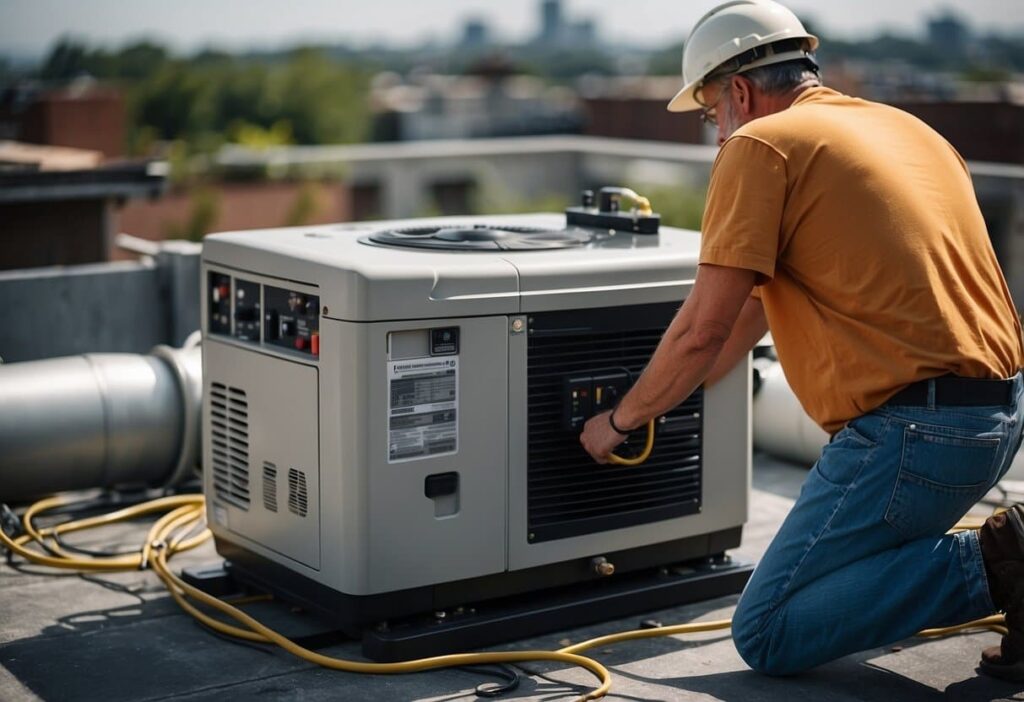
A standby generator provides backup power during outages. It can keep essential systems running and offer peace of mind.
Understanding Power Outages
Power outages can happen for many reasons. Severe weather, equipment failures, and accidents are common causes. Some outages last minutes, while others can go on for days.
Frequent or long outages can be very disruptive. They may spoil food, stop heating and cooling systems, and cut off communication. For businesses, outages can lead to lost income and productivity.
It’s helpful to track how often outages occur in your area. Keep a log of when they happen and how long they last. This information can guide your decision about getting a generator.
Benefits of a Standby Generator
A standby generator kicks in automatically when the power goes out. It can power your whole house or just key items. This backup power keeps life running smoothly during outages.
With a generator, you can keep your fridge cold and your lights on. Your heating or air conditioning will work too. You’ll be able to charge phones and use computers.
For some, a generator is more than convenient – it’s vital. People who work from home need power to do their jobs. Those with medical devices rely on electricity for health reasons.
Generators also protect against water damage from frozen pipes in winter. They can help prevent mould growth in basements after heavy rains and power loss.
Selecting the Right Generator
Choosing an appropriate generator for roof installation requires careful consideration of fuel types and power output. The right generator will provide reliable backup power while meeting local regulations and your home’s energy needs.
Generator Types and Fuel Sources
Roof-mounted generators come in various fuel options. Natural gas generators connect to existing gas lines, offering continuous operation. Propane generators use tanks that need refilling but burn cleaner than other fuels. Diesel generators are durable and efficient but may have storage limits. Gasoline models are common but require frequent refuelling.
LP gas (liquid propane) generators are another option, using the same fuel as many home appliances. Each fuel type has pros and cons in terms of cost, availability, and runtime. Consider your area’s fuel accessibility and storage regulations when deciding.
Determining Appropriate Size and Watts
Calculating the right generator size is crucial. Whole-home generators typically range from 7,500 to 38,000 watts. List all appliances and devices you need to power during an outage. Add up their wattage requirements, including starting watts for motors.
A professional can help determine the correct size. Undersized generators won’t meet your needs, while oversized ones waste fuel and money. Home standby generators often come in set sizes, so you may need to round up to the next available option.
Consider future needs and any planned additions to your home. It’s better to have slightly more capacity than not enough. Remember, roof installations may have weight limits, affecting your size options.
Legal and Safety Considerations
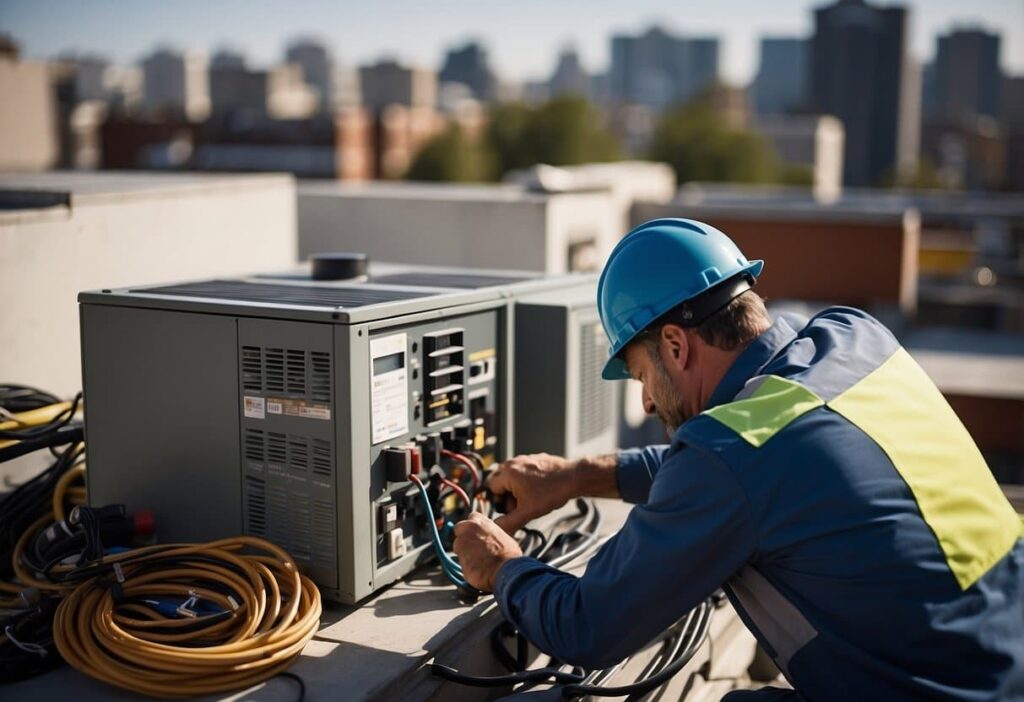
Installing a generator on your roof comes with important legal and safety requirements. These rules protect you, your neighbours, and your property. Let’s look at the key things to keep in mind.
Permitting and Local Code Requirements
Most areas need permits for rooftop generator installations. Check with your local building department first. They’ll tell you what permits you need. Building permits make sure the work is safe and follows local codes.
Local codes cover things like:
- Generator size and power output
- Noise levels
- Fuel storage
- Electrical connections
A licensed electrician should handle the electrical work. They know the rules and can install things safely. The building department may want to inspect the work when it’s done.
HOA Restrictions and Neighbor Relations
If you live in an area with a homeowners association (HOA), check their rules. Some HOAs don’t allow rooftop generators. Others may have strict rules about size, noise, or looks.
It’s nice to talk to your neighbours before installing a generator. Tell them your plans. This can prevent issues later. Some ways to be a good neighbour:
- Choose a quiet generator
- Install sound barriers
- Run the generator only when needed
- Keep it well-maintained to reduce noise
Carbon Monoxide and Exhaust Planning
Generators make carbon monoxide. This gas is deadly. Plan the exhaust system carefully. It must vent away from your home and your neighbours’ homes.
Key exhaust planning points:
- Use proper exhaust pipes
- Direct exhaust up and away from buildings
- Install carbon monoxide detectors in your home
- Keep the generator far from windows and doors
The exhaust system must follow local codes. A pro can help design a safe system. Regular maintenance keeps the exhaust system working right. This protects everyone from harmful gases.
Preparing for Installation
Before installing a generator on your roof, careful planning and preparation are essential. Proper site selection and setup of connections will ensure a safe and effective installation.
Site Selection and Preparations
Choose a spot on the roof that can support the generator’s weight. The area should be flat and structurally sound. Check local building codes for any restrictions on roof-mounted generators.
Clear the chosen area of debris and obstacles. Install a sturdy platform to distribute the generator’s weight evenly. This platform should be anchored securely to the roof structure.
Ensure easy access for maintenance and refuelling. Create a safe path to reach the generator. Install railings or safety harnesses if needed.
Weather protection is crucial. Set up a shelter or enclosure to shield the generator from rain, snow, and extreme temperatures.
Fuel Line and Electrical Connections
Plan the fuel line route from the gas meter to the generator. Use proper materials suited for the fuel type. Ensure all connections are tight and leak-free.
Install shut-off valves at key points along the fuel line. This allows for quick fuel cut-off in emergencies.
Map out the electrical connections. Determine where the generator will tie into the building’s electrical system. Install a transfer switch to safely manage power between the generator and the main grid.
Run conduits for electrical wiring. These should be properly sealed and weatherproofed. Label all wires clearly for easy identification during installation and future maintenance.
Installation Process

Installing a generator on your roof requires careful planning and expert help. Safety and proper setup are key for a successful installation.
Contractor Consultation and Quotes
If you’re not sure who to ask, you can start by contacting licensed electricians who specialize in standby generator installation. Ask for detailed quotes that cover all aspects of the project. Make sure they explain the entire process and answer any questions you have.
Get at least three quotes to compare prices and services. Check each contractor’s credentials and read customer reviews. This helps ensure you choose a qualified professional for the job.
Luckily for you, we know a VERY good electrician in Whitby-Scott Beetham! Here are the details:
The chosen electrician will assess your home’s electrical system and roof structure. They’ll determine the best generator size and placement for your needs.
Foundation Requirements
A solid foundation is crucial for roof-mounted generators. The electrician will check if your roof can support the generator’s weight. They may recommend reinforcing the roof structure if needed.
Most installations use a concrete slab or pea gravel base on the roof. The slab provides a level surface and helps distribute the generator’s weight evenly.
The foundation must be waterproof to prevent leaks. Proper drainage around the generator is also important to avoid water damage to your roof.
Installing the Transfer Switch
The transfer switch is a vital component of your generator system. It safely connects the generator to your home’s electrical panel.
The electrician will install the transfer switch near your main electrical panel. They’ll wire it to both the panel and the generator.
This switch automatically detects power outages. When the power goes out, it disconnects your home from the utility grid. Then it switches to generator power.
The transfer switch also prevents backfeeding. This keeps utility workers safe when they’re repairing power lines during outages.
Finishing Touches
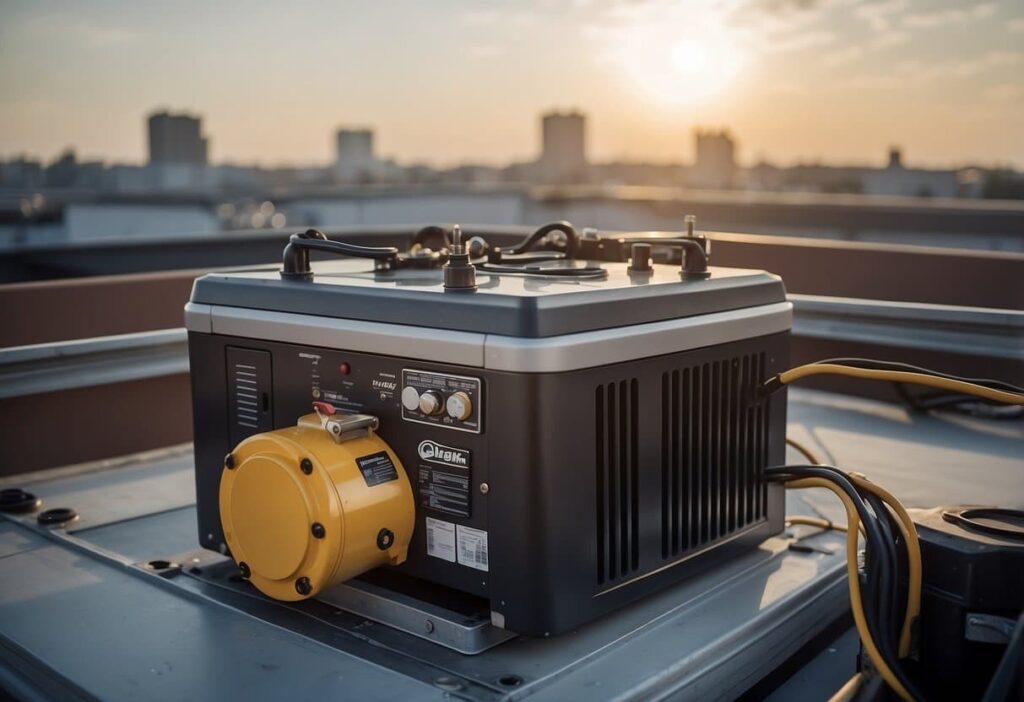
The final steps in installing a roof generator involve protecting it from the elements and ensuring optimal performance. These measures help safeguard your investment and maintain its efficiency.
Weather Proofing and Noise Reduction
Protecting your roof generator from harsh weather is crucial. Install a weatherproof enclosure to shield it from rain, snow, and wind. This helps prevent water damage and rust. Choose materials that can withstand extreme temperatures and UV rays.
To reduce noise, add sound-dampening materials inside the enclosure. This cuts down on vibrations and muffles the generator’s sound. Install rubber mounts between the generator and the roof to absorb vibrations.
Consider adding extra insulation to protect against flooding risks. This is key in areas prone to heavy rains or melting snow. Make sure any openings are properly sealed to keep water out.
Testing and Fine-Tuning
After installation, thorough testing is a must. Run the generator under different loads to check its performance. This helps spot any issues early on.
Check all connections and fuel lines for leaks or loose fittings. Make sure the exhaust system is working correctly to prevent carbon monoxide buildup.
Test the automatic transfer switch if you have one. This ensures a smooth power transition during outages. Adjust the voltage and frequency settings if needed for optimal output.
Set up a regular maintenance schedule. This should include oil changes, filter replacements, and general inspections. Proper upkeep helps your generator run smoothly for years to come.
Maintenance and Upkeep
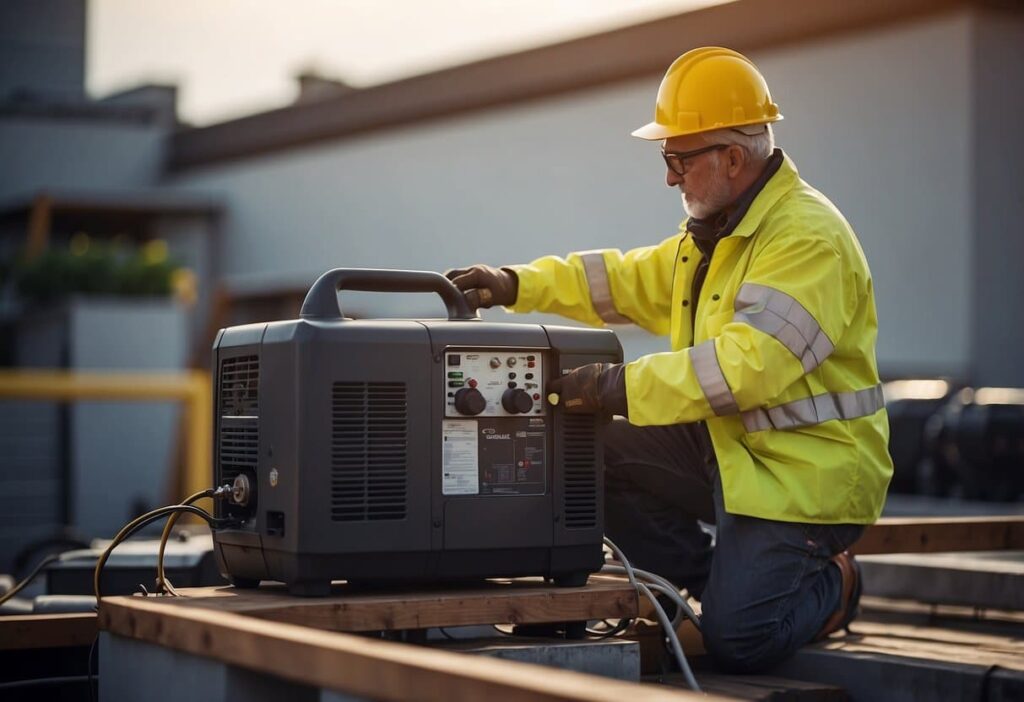
Proper care of a roof-mounted generator ensures reliable performance and extends its lifespan. Regular check-ups and DIY tasks help keep the system in top shape.
Regular Checkups and Professional Servicing
Generators need expert care to run smoothly. Schedule yearly inspections with a licensed electrician. They’ll check wiring, fuel lines, and other key parts. The pro will also test the generator’s output and safety systems.
During these visits, the tech might replace worn components. This helps prevent breakdowns when you need power most. Keep a log of these check-ups for warranty purposes.
Some companies offer service plans. These can save money in the long run. They often include priority service during outages.
DIY Maintenance Tips
Between pro visits, there are tasks you can do to keep your generator healthy:
- Check oil levels monthly
- Clean or replace air filters as needed
- Remove debris from around the unit
- Test the generator monthly for 15-30 minutes
Keep a supply of fresh fuel on hand. Old gas can harm the engine. Use a fuel stabilizer if you store gas for long periods.
Watch for odd noises or smells during test runs. These could signal problems. If you notice issues, call a pro right away.
Always follow the maker’s guide for your model. It lists specific care tips and how often to do them. With good care, your roof generator will be ready when you need it most.
Cost Considerations
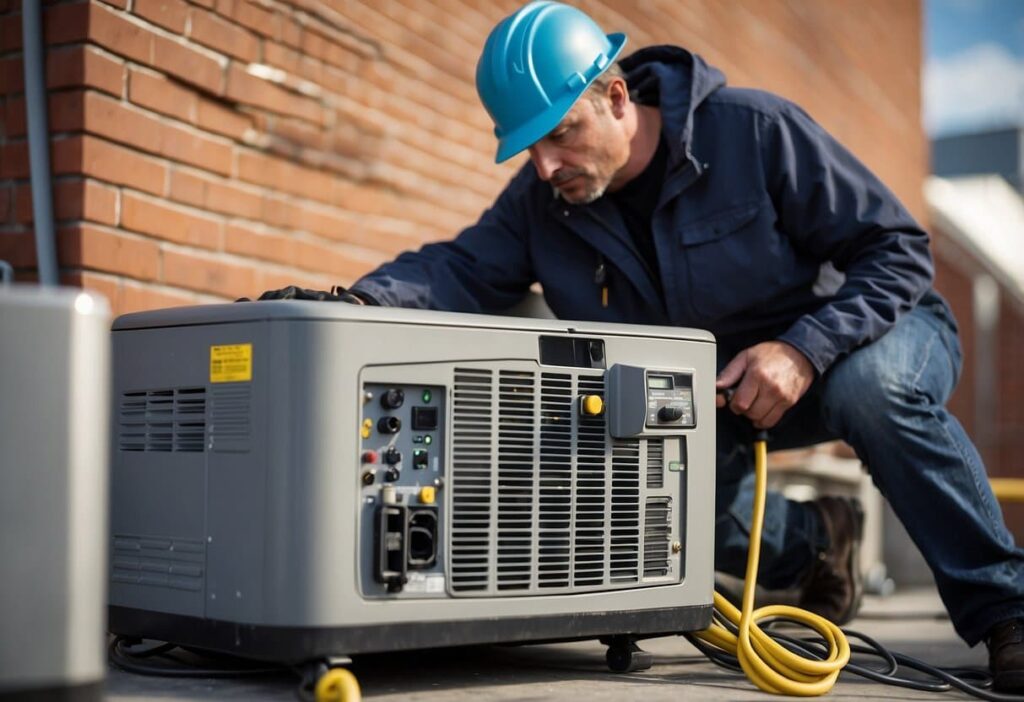
Installing a generator on your roof involves several expenses. Let’s break down the main costs you’ll need to plan for.
Estimating Installation Cost
The cost to install a rooftop generator ranges from $5,000 to $15,000. This price includes the generator unit and labour. Larger homes or more powerful generators will be on the higher end.
Several factors affect the total cost:
- Generator size and power output
- Roof type and accessibility
- Electrical system upgrades
- Permits and inspections
Some areas may require special mounting systems or reinforcement, adding to the expense. Always get quotes from multiple licensed electricians to compare prices.
Operating and Maintenance Expenses
Running a rooftop generator comes with ongoing costs. Fuel is the biggest expense, varying based on generator type and usage. Natural gas generators are often cheaper to run than propane or diesel.
Regular maintenance is crucial for keeping your generator working well. Expect to spend $200 to $500 per year on:
- Oil changes
- Filter replacements
- Battery checks
- General inspections
Set aside money for potential repairs. Parts can wear out over time, especially with frequent use. Budget for occasional service calls from a professional technician.
Conclusion
Installing a generator on the roof requires careful planning and professional help. An electrician is essential for safe and proper installation. They have the skills to connect the generator to your home’s electrical system correctly.
Standby generators offer reliable backup power during outages. Proper placement on the roof can save space and reduce noise. But it also comes with challenges like weight and weather exposure.
Timing is key when scheduling the installation. Choose a day with good weather to ensure safety for workers on the roof. Plan for the process to take several hours or even a full day.
Remember to follow local laws and get the necessary permits before starting. Regular maintenance will keep your rooftop generator running smoothly for years to come. With the right preparation and professional help, a rooftop generator can be a valuable addition to your home.
Frequently Asked Questions
Installing a generator on a roof requires careful planning and professional expertise. Safety codes, costs, and proper electrical connections are key considerations.
What are the requirements for installing a generator on a rooftop?
Rooftop generator installations need a sturdy, flat surface. The roof must be able to support the generator’s weight. Proper ventilation and noise reduction measures are needed.
Building permits are often required. Local zoning laws may restrict rooftop installations. A structural engineer should assess the roof’s capacity.
Who is qualified to perform a rooftop generator installation?
Licensed electricians with generator installation experience should handle rooftop setups. They understand electrical codes and safety requirements.
HVAC technicians may assist with fuel line connections for gas generators. Roofers might be needed to ensure proper weatherproofing and structural integrity.
What is the typical cost of a standby generator installation?
Standby generator installations usually range from $5,000 to $15,000. Costs vary based on generator size, fuel type, and installation complexity.
Rooftop installations may cost more due to added labour and equipment needs. Permits, electrical upgrades, and fuel line work can increase the total price.
How far should a generator be placed from a house according to the code?
Most codes require generators to be at least 5 feet from windows and doors. This helps prevent exhaust fumes from entering the home.
Rooftop installations may have different distance requirements. Local building codes should be consulted for specific rules.
Is it necessary to hire an electrician for generator hookup?
Yes, hiring a licensed electrician for generator hookups is crucial. They ensure proper wiring and compliance with electrical codes.
Electricians can install transfer switches and connect the generator to the home’s electrical panel safely. This prevents back feeding and protects utility workers.
Can a homeowner install a generator transfer switch on their own?
While some homeowners may have the skills, it’s not recommended to install a transfer switch without proper training. Electrical work can be dangerous.
Incorrect installation can lead to fires, electrocution, or damage to the home’s electrical system. Professional installation ensures safety and code compliance.
